Sutton Bay
SD, USA
Green Keeper: Brian Thompson
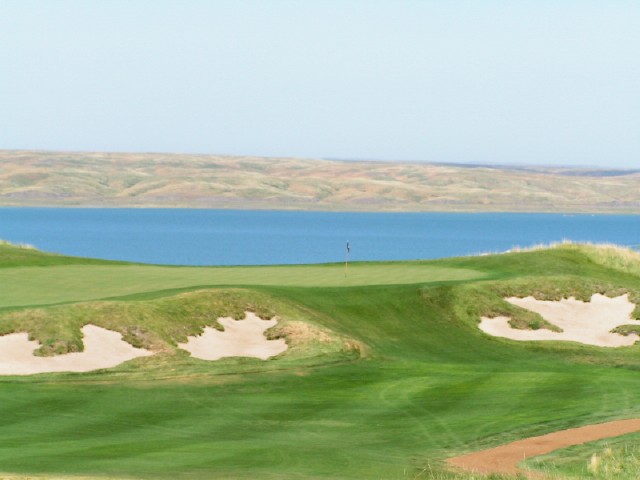
With sweeping views across Lake Oahe…
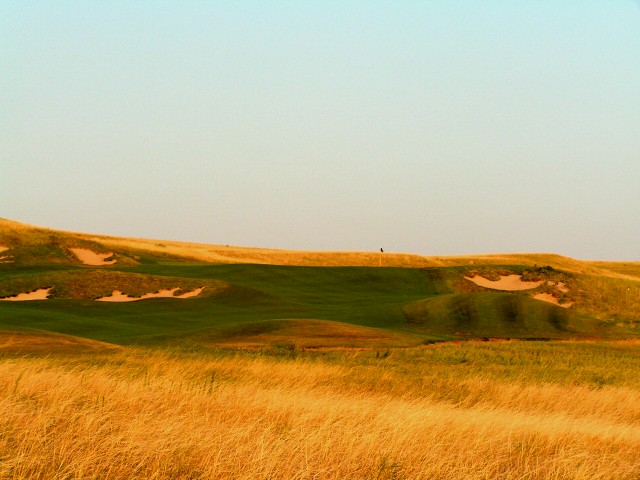
…coupled with the prairie lands of South Dakota, no golfer can resist the allure of a game at Sutton Bay.
One of the more misleading statements bandied about in recent times is ‘Build it and they shall come.’ Scores of courses located just twenty or thirty miles from population centers are finding minimal interest from golfers in playing their fine but nothing special course. However, slightly change the statement to read ‘Build a great course and they shall come’ and there is both current as well as historical support.
Beginning along some of the remote parts of the Scottish coastline and followed by Stanley Thompson in some of Canada’s most stunning environs, great courses have attracted golfers for decades. On a worldwide basis, modern day golfers seek out courses in Bali, New Zealand, and Australia in order to enjoy great golf in unparalleled settings. In the United States, courses in Nebraska and along the coastline of Oregon have captured the same feeling of escaping from it all as some of these more exotic world locations. Yet, the key to success for the long term for these courses is predicated on the design of the course being excellent to the point where people are drawn for return visits. Therein lies the rub as few designs ever achieve the lofty goal of leaving the golfer with the strong desire to play a course again and again. Most designs lack variety, are too penal, are too one dimensional in their insistence on aerial approach shots, and in general lack golf holes with compelling strategy/qualities. Plus, many modern courses with their elevated tees and flattened landforms unveil their secrets after just a round or two. With little mystery remaining, why bother for a return game on any frequent basis?
To build a remote course that successfully appeals to people as a place to escape requires patient owners. Everything must be done right and that requires time. If any part of the creative process breaks down – the selection of the land, getting the routing and design details right, the construction process – the project will likely struggle. Though the task can be daunting, the golf world cheers when it is done right and such is the case with Sutton Bay, located forty miles northwest of Pierre, South Dakota. For over a decade, South Dakota native Mark Amundson longed to establish a retreat for golf, hunting and fishing. Of the properties he visited, one component or another was always lacking, or at least not quite unique enough to act asa lasting draw. That changed in 1995 when he was introduced to Matt Sutton, a rancher whose family worked the property that Sutton Bay now occupies a portion of for over 100 years. Bordered on one side by Lake Oahe, this remote ranch/property was one of a kind, blessed with many natural and unique landforms. The hunting (South Dakota is famous as the world’s pheasant hunting capital) and fishing/boating (walleye are abundant and Lake Oahe is over two hundred miles long and two miles wide) were the easy parts. Designing a golf course full of charm and challenge would take considerably more time and resources.
Mark Amundson knew Australian Graham Marsh as a player and a person for years. He had followed Graham Marsh‘s ever growing golf course design career. Highlighted by The Vines in Western Australia and Terrey Hills outside of Sydney and numerous highly regarded courses across Asia, Mark Amundson was keen for the Australian to come see this piece of property. Not long into Graham Marsh‘s first visit, Mark Amundson knew he had his architect. As for building the course that Graham Marsh would design, Mark Amundson was aware of a Sand Hills member by the name of Bill Kubly, whose firm Landscapes Unlimited could help with the irrigation and course construction. Once Kubly visited the property in 1999, he too realized this was a once in a lifetime opportunity. In addition to having Landscapes Unlimited construct the course, Kubly signed on as an investor. As Graham Marsh writes in the yardage book, “The brief for the golf course was simple. The course should be playable yet challenging , keep earthworks to a minimum, and preserve the natural landscape.” The course is the classic out and back routing, with the ninth green being two and a half miles from the first tee.
Course construction began late in the summer of 2001 and the course opened for limited play two years later.
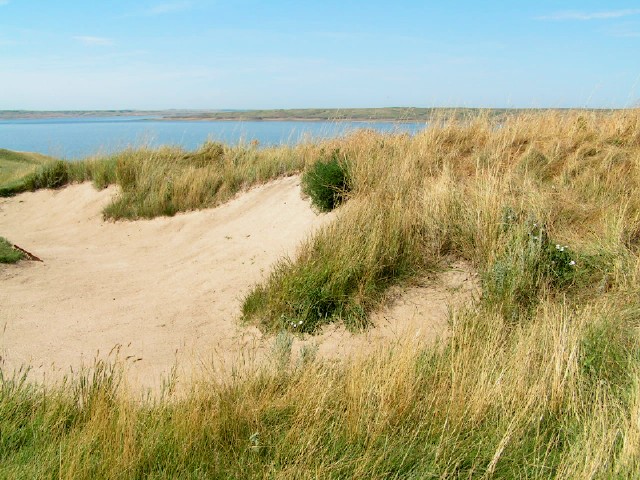
The construction technique of stacking sod gives the bunkers a maturity well past the course’s 2003 opening.
Certainly, the memories from the first several visits are dominated by thoughts of playing golf in such a wonderful and secluded setting. The golfer is free to enjoy the pristine South Dakota setting as no man-made structure unrelated to the club/course can be seen at any point during the round. Lake Oahe, the unique landforms, the native grasses, the sprawling bunker complexes and the wind make Sutton Bay a course like no other. Yet, years from now after many, many rounds, will members continue to relish a game with the same enthusiasm?
The answer is yes, thanks to the outstanding quality and variety of the golf holes that were crafted from this landscape. Numerous classic features, of the exact sort that have drawn golfers to St. Andrews for years to solve the riddles of The Old Course, are present to keep the challenge forever fresh and enjoyable.
Holes to Note
First hole, 660/580 yards; For thousands of years, rain water sought ways to get from the high prairie to the nearby river. A portion of that river, now known as the Missouri River, was dammed in 1960, creating Lake Oahe. The entire Sutton Bay course is routed in, over and around the stunning landforms that were shaped into dunes by the rain water. As shown here at the first, the fairway swings left around high mounds 300 yards from the tee and then bends right around another set of dunes that begin 150 yards from the green.
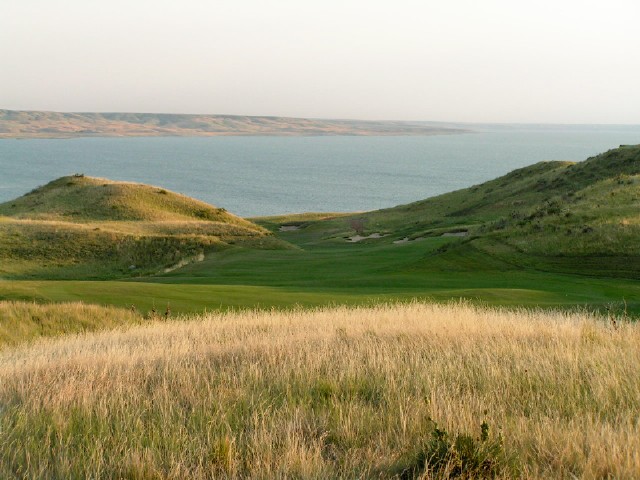
A look down the long 1st fairway as it twists and turns past unique landforms of the Missouri Breaks.
Third hole, 395/375 yards; Given the current technology boom with golf equipment, modern day golf architects strugglemightily with ways to createmedium lengthholes ofinterest. When in doubt for a solution, looking toward The Old Course at St. Andrewsis always a good idea. A self professed lover of The Old Course, Graham Marsh copied one of its most famous – and least understood – design features: the fallaway green. Like The Old Course, Graham Marsh didn’t just have one or two greens slope from front to back but builtsix plusgreens scattered throughtout the course that have a significant front to back slope at some point in the putting surface. In the case of the 3rd, beautifully adapted to this South Dakota landscape, Graham Marsh perched the green atop a hillock some 400 yards from the tee. A false front gives way to the crest of the green and then it falls from the front toward the back left. Downwind during the summer playing months, the good player looks at the modest yardage and wide fairway and automatically pulls driver. The trap is sprung at this point and as with The Old Course, the secret to playing the hole may only be learnedwith time. Even if the tiger golfer finds the narrowing fairway80 to100 yards from the green, he is left with an awkward length pitch downwind to a green that runs away. Over time, the golfer will likely come to hope for a fuller shot in, one that he can spin to better combat the downwind/front hole locations at the neat 3rd. To ask a golfer to considerrestraint to a wide open fairway is a wonderful question that few architects pose.The key element to that question is nearly always a fallway green.
A rarity in modern golf – a sub 400 yard hole of great interest. Restraint from the tee will serve the golfer well.
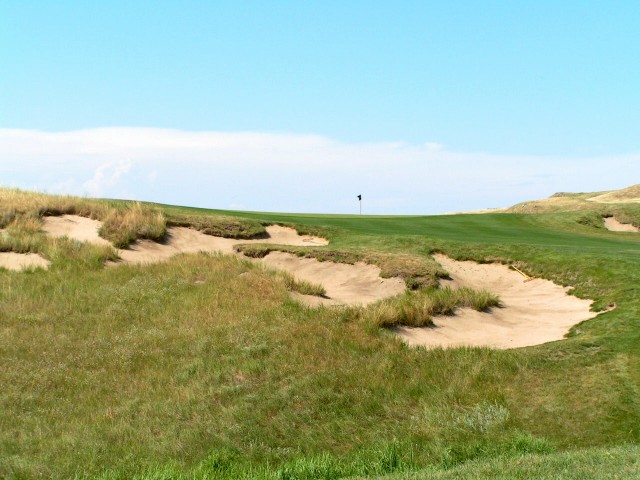
The flag tells the story. Both a forward hole location and the summer wind (i.e. the wind is behind the golfer on the outward journey) conspire to make this hole location tough to get near. Just a tad short and the false front sends the ball back into the fairway.
Fourth hole, 651/553 yards; This beautifully sweeping three shotter bends left and falls down the hill toward the green with the lakein the background. The green is an extension of the fairway and thus falls away from the golfer too. This attribute determines the entire strategy for playing the hole. If going for the green in two, the golfer wants to miss the green long, leaving a relatively straight forward uphill chip back to the hole. If the golfer is laying up, he wants to do so down the left of the fairway to avoid a pitch directly over the front bunker that obscures the right half of the green. Golfers often become lazy when playing American courses because almost every green slopes toward the golfer. The strategy of where to miss shots is not all encompassing as the notion of over the green is generally removed from the equation. The owners of Sutton Bay did themselves and golfers a great service when they selected an overseas architect, one not tied to formulaic approach to golf course design that currently plagues the big name American architects.
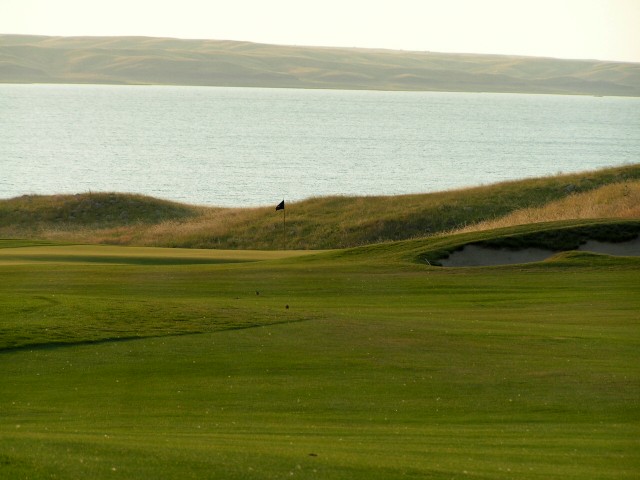
Compare the angles of approach in these two photographs: from the left portion of the fairway, the golfer feels he may get his pitch close to the 4th hole while from the right portion…
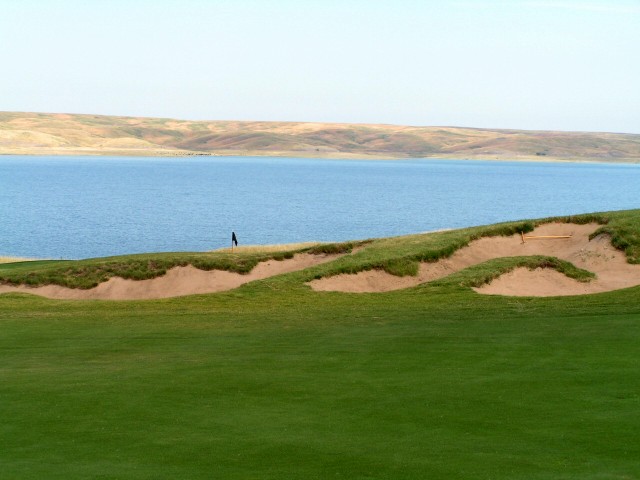
…of the fairway, the golfer is not nearly as hopefully of a positive outcome to this fallaway green.
Fifth hole, 175/165 yards; In windy locales, the architect has to be selective in building green sites that don’t allow a running approach shot. When brisk winds are coupled with one forced carry after another, most golfers become overwhelmed and the joy of the round is lost at some point. Though the owners and Graham Marsh were after a challenging course, it was never to be at the expense of playability at Sutton Bay. The fifth is one of the few forced carries to a green on the course but the natural valley it plays across makes it too good a green site to pass up. As Graham Marsh notes, finding one shot holes given the diverse topography was the easy part in routing the course; the real challenge was in finding the two and three shotters that would connect all the holes.
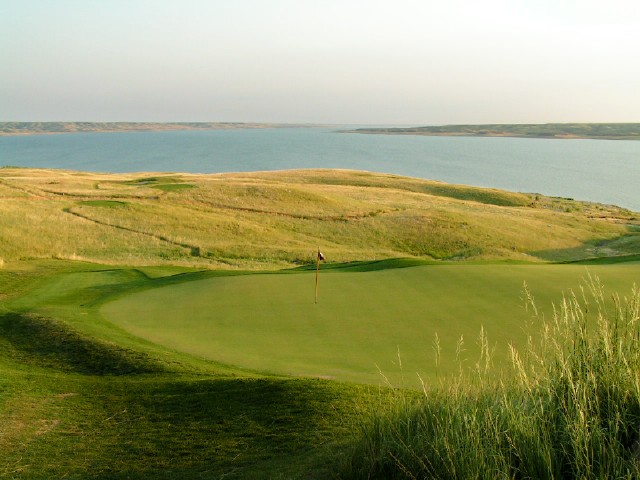
As seen from behind the 5th green, this one shotter plays across a natural valley. Note how the tees in the distance are at grade with their surrounds. To build the tees up would have been a blight as it would have shown man’s heavy hand upon the landscape.
Sixth hole, 435/405 yards; A beautifully conceived hole: the upper right portion is wide and easy to hit off the tee yet it affords the less advantageous angle into the green. Between 115 and 160 yards from the green, this upper portion of the fairway swings left sharply, dropping thirty feet to the lower fairway which proceeds up to the green. From the lower fairway, the golfer has a perfectview of the green and has high hopes of a good approach and a one putt birdie. Thus, the rub is whether the golfer can somehow access the lower fairway off the tee. On the fly, can he carry the gully and land his ball onto the lower fairway? Or should he can aim at the large 45 yard long green side bunker, recognizing that this line will take his ball to the crest of the upper fairway and with any luck his ball will then trundle down the slope into the lower fairway. It is worth noting that the fairway is 83 yards wide at the 150 yard mark from the green, a staggering amount of width. Yet such width was not extraneous in the least as it allowed Graham Marsh to capture a natural landform within the fairway from which the hole’s entire playing strategy spins off.
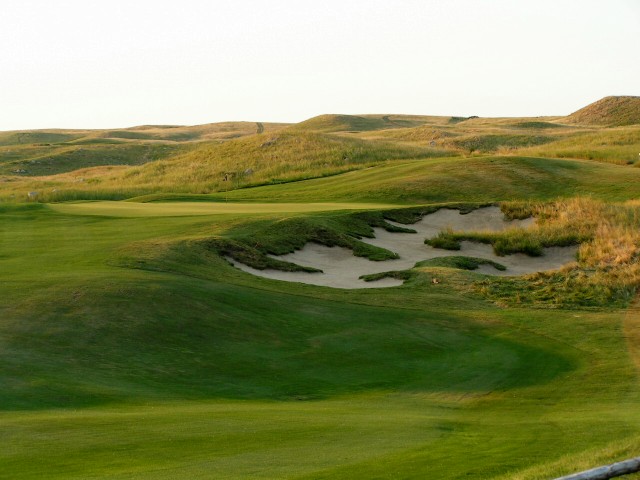
The large greenside bunker can be used as an aiming point from the 6th tee. The ideal angle of approach is from the left (i.e. lower) fairway.
Seventh hole, 405/385 yards; If property is blessed with good movement, it is up to the architect to find the routing that showcases the topography and creates the most variety in shots. Here the seventh plays sharply downhill as well as in a wind direction that the golfer has yet to face. The approach is rarely from a level lie, making distance control to the shallow green hard to judge.
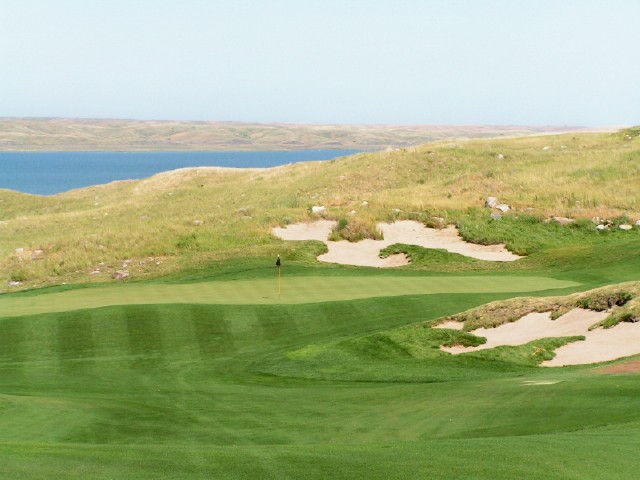
The shallow 7th green with its strong right to left tilt.
Eighth hole, 610/575 yards; As the golfer strolls the course, he is presented with a varied and lovely array of backdrops to the greens, everything from long views across Lake Oahe to skyline greens to here at the eighth of a massive dune behind the green. The first two shots set up the golfer with the best look at this green complex. At over 10,000 square feet, it is one the largest on the course. As golfers have found for eighty years at Yale Golf Club, getting an approach close to the hole on a large green is no mean feat. The task is made all the more tricky here as the putting surface is obscured by a large bunker complex that commences 70 yards shy of the green. The large green is angled from back left to front right and the golfer must get his approach on the right side of the ridge that bisects the green; otherwise, a three putt is all too common.
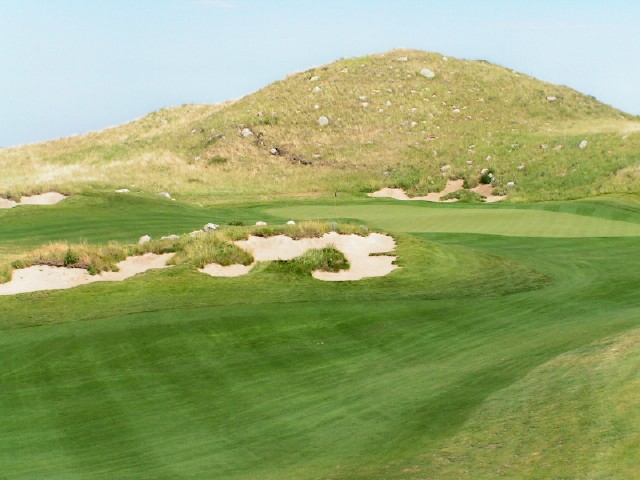
The boulders on the mound behind the 8th green were deposited milleniums ago by glaciers. The Sutton Bay site is a rocky one, which was a factor during construction. Kulby’s construction crew was charged with removing the boulders from where bunkers were created, often taking several truck loads per bunker given how large the bunkers ended up being.
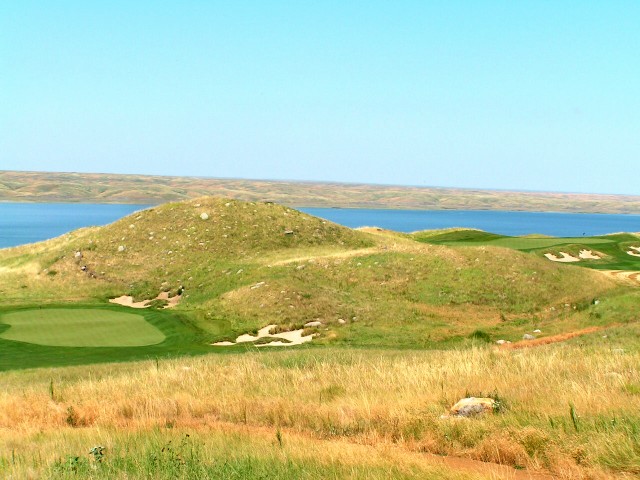
A glorious view of the 8th green in the foreground and the one shot 9th in the distance.
Ninth hole, 205/180 yards; Destined to become one of the most photographed holes in the country, the ninth hole features elevated tees that afford the golfer a view across a shallow valley to the long green as it feeds off a shoulder from the hill behind the eighth green. Views across Lake Oahe to the rolling prairies on the far side go for miles. In contrast to the last green, this one is angled from front left to back right and a fade is the ideal ball shape.
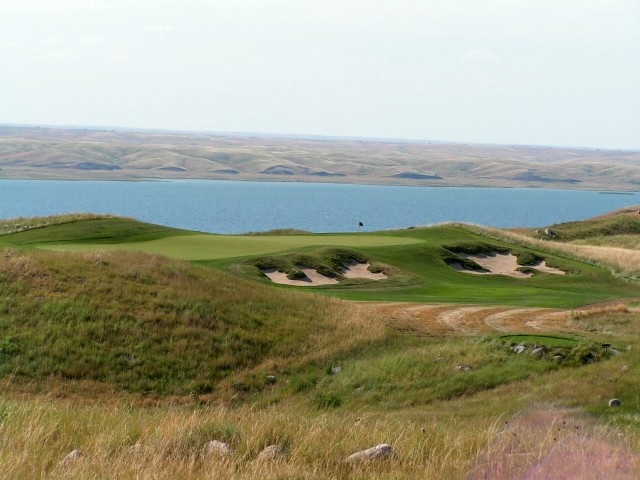
The 9th is not just about beauty as there is plenty of strategy to consider. The left hole locations play a club or two shorter than the right ones on this long angled green. Also, there is a mound behind the left of the green that might aid an overaggressive tee ball return to the green – but only on that side. Any tee ball hit long of the upper right portion of the green is kicked further away from the putting surface.
Eleventh hole, 560/535 yards; Marsh’s varied use of landforms lends the course great interest off the tee. If the golfer carries a large mound left off the eleventh tee, the tee ball catches the down slope and the green is brought within reach in two for the tiger golfer. Further ahead, a central hazard one hundred yards shy of the green creates all sorts of indecision for the rest of us laying up.
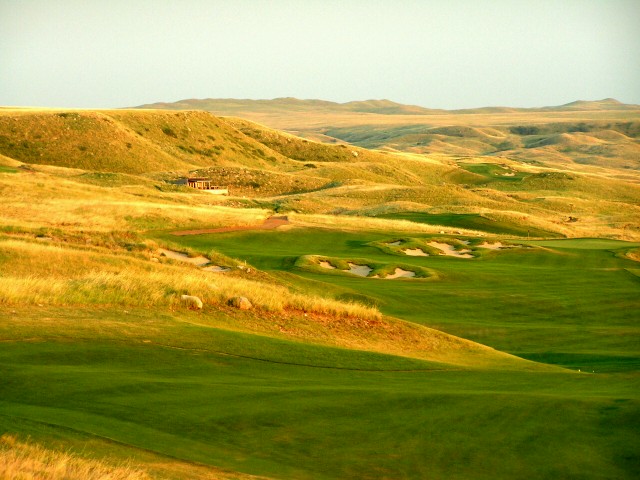
A big tee ball left over the native mound may bring the 11th green in reach. Note the great placement of the central fairway bunker into the ridge line 100 yards from the green.
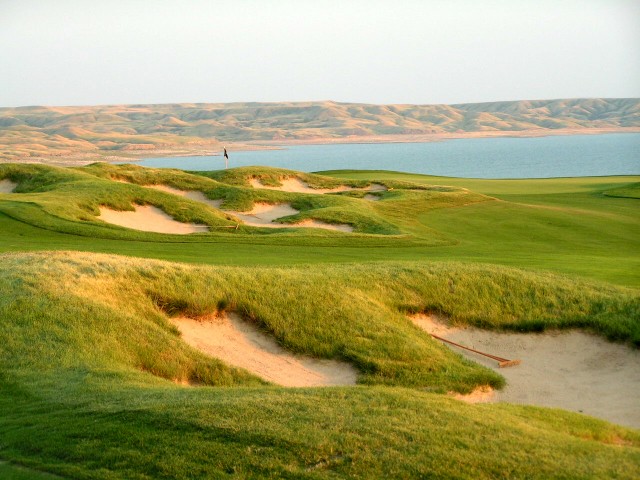
Taken from 110 yards from the green, this photograph highlights the variety of hole locations that are possible. With nothing behind the green to comfort the golfer, the hole locations on the back right upper plateau are especially vexing.
Twelve hole, 400/370 yards; Options galore off the tee once the golfer appreciates the number of ways the hole can be played based on the day’s wind and hole location. Considering that it plays into the summer wind, sometimes the golfer is delighted to be just at the base of the large fairway bunker in the photograph below. With the wind down, the golfer will turn his focus off the tee farther ahead toset up the ideal approach angle into the green based on the day’s hole location (i.e. to the opposite side of the fairwayfrom the day’s hole location). The elevated green features the most severe false front on the course and is adept at returning the modestly struck ball well back into the fairway.
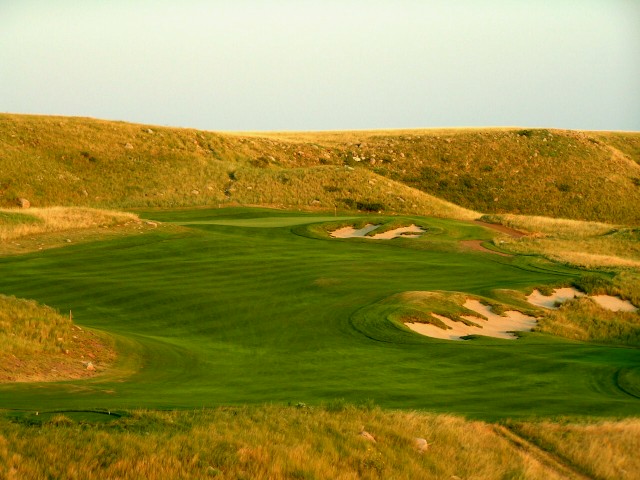
The view from the 12th tee captures one common demoninator throughout and that is the huge scale. Imagine the opposite (i.e. the fairway was narrow and straight and the bunkers were small) , and one begins to appreciate how well the course features compliment its native surrounds.
Thirteenth hole, 215/185 yards; Given that the returning nine plays along the high side of the sloping land, it isexpected that a hole like this would find its way into Marsh’s routing. From the back tee, the hole drops 80 feet to the green below. By building such a drop shot hole that heads predominately toward the lake, the architect accomplished several things, namely he highlights the pitch of the property, he affords the golfer stunning long views, and he provides a break in the direction of the holes leaving the golfer to puzzle over what effect the wind will have on this angle shot. Also, in keeping with the fourth green, the architect lets the green follow the natural slope of the land, thus creating another fine front to back sloping green.
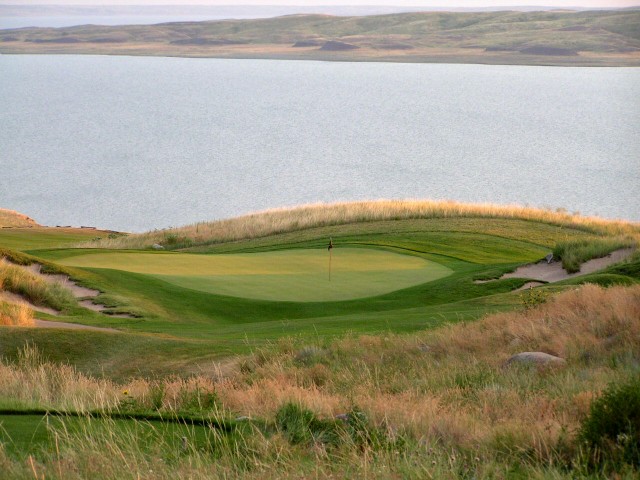
This is actually not that easy a hole location. Any tee ball less than well hit drifts toward the back left of the green. For the golfer not mesmerized by the distant views, it is a delight to watch the drama unfold with the slow roll of the ball on the putting surface.
Fourteenth hole 420/375 yards; Two classic design features make this one of the two or three finest holes at Sutton Bay. First the drive is through a saddle to a landing area that is blind off the tee. Though unsettling, the fairway is one of the widest off the course and there is no excuse for missing it. Alister MacKenzie was a long time proponent of giving the golfer something fearsome to accomplish and then letting the golfer bask in delight at having accomplished it. The approach is uphill to a skyline green. From down below in the fairway, the golfer is left to guess as to the affect that the wind will have on this shot.
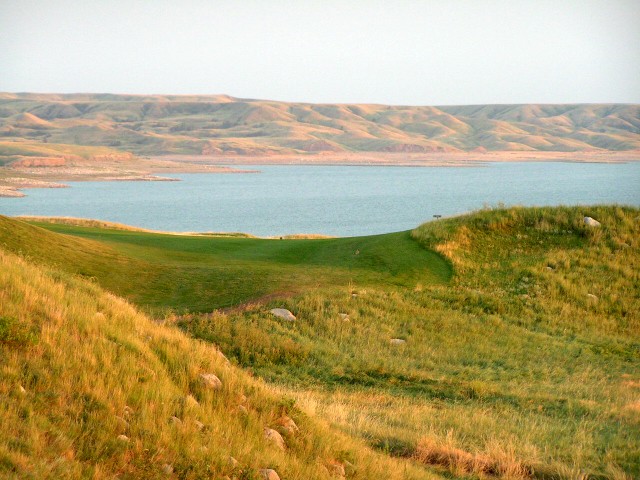
A view from the 14th tee at Sutton Bay is more reminiscent of one that golfers find on some of the thrilling links in Ireland or Scotland.
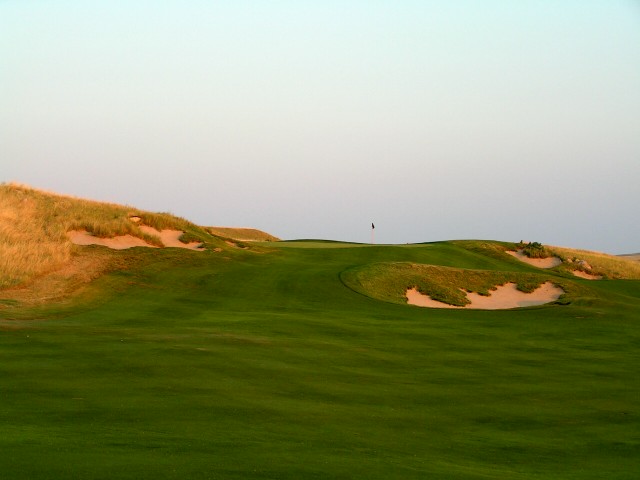
The beautiful skyline green at the 14th.
Fifteenth hole, 530/505yards; Of the five three shot holes on the course, none are remotely alike. There is always something different to do/accomplish, an impressive feat of design. In the case of the fifteenth, the dominant fairway bunker off the tee guards the only level portion of the fairway, a must find for those hoping to reach this – the shortest of the three shotters – in two. The green complex itself is noteworthy as being a fine example of a design change made in the field. Originallyto be further left and higher, Marsh eventuallyconcluded that today’s green location beside a mound on the right would make a more tactically engaging hole – and he was right. Many lay up shots feed off the left to right fairway slope into a bowl, leaving the golfer in the far right side of the fairway. With the green now hugging the mound on the right, numerous right hole locations create a taxing angle for the pitch. Tying the natural slopes in the land to a natural feature bya green site is one of the benchmarks of all great designs.
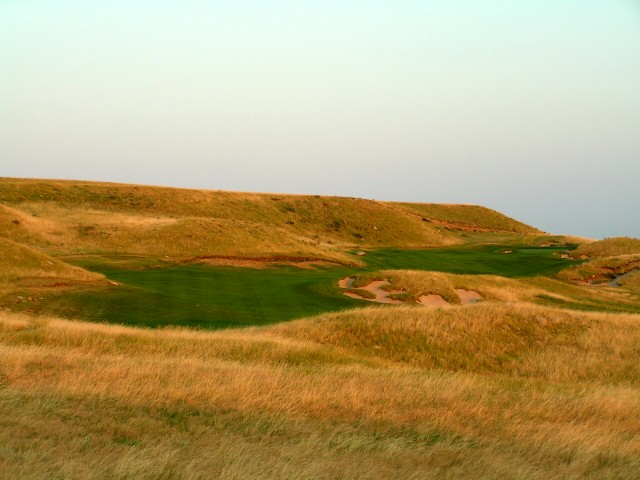
The 15th plays along the base of the mesa.
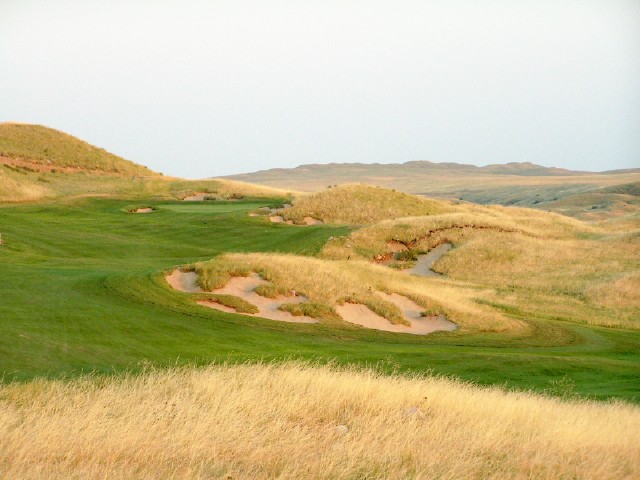
Look at Marsh’s great use of the ground, namely (1) the only level portion of the fairway is guarded by the first fairway bunker, (2) the bowl further ahead sucks balls to the right, and (3) the green’s location is hard against the natural mound on the right. These attributes give the 15th lasting playing strategy. The ideal lay up shot is often high down the left side of the fairway…
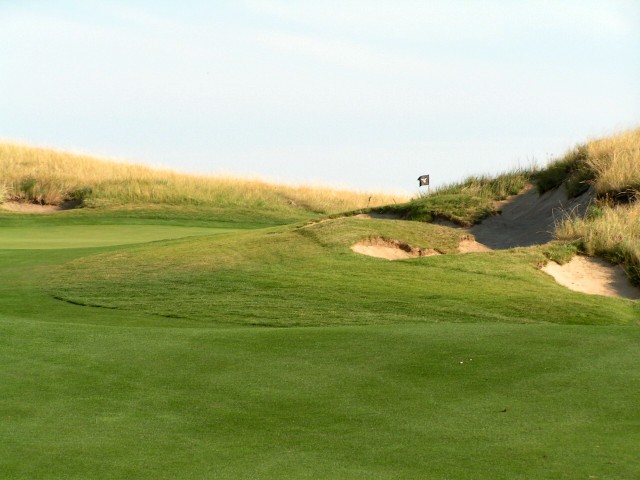
…as a pitch from the right to right hole locations is no bargain.
Sixteenth hole, 445/405 yards; A perfectly designed hole as all levels of player will take great delight in playing it. The large central hazard is well positioned into the natural rolls of the fairway and has the effect of creating two fairways: the upper one affords the best angle into the green and the lower one provides scale and width that matches the setting of the hole. Plus, the expanse of fairway provides comfort for golfers of all levels to make a bold and confident swing.
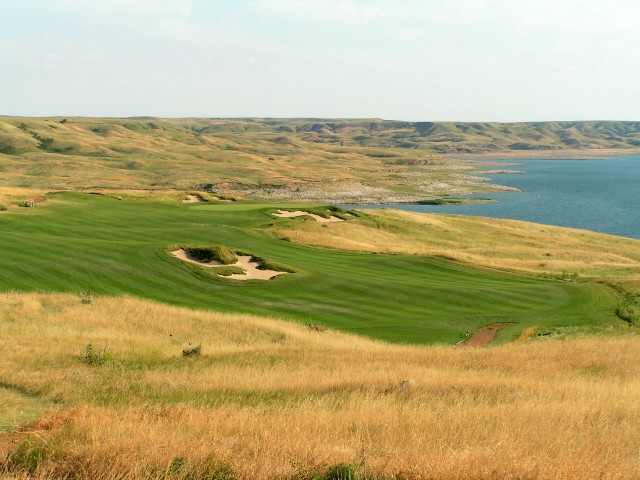
Watching a well hit tee ball bore the wind and drop from the sky against the background above is something the golfer will long remember. The challenges of one’s regular course at home might begin to seem a little pedestrian in comparison.
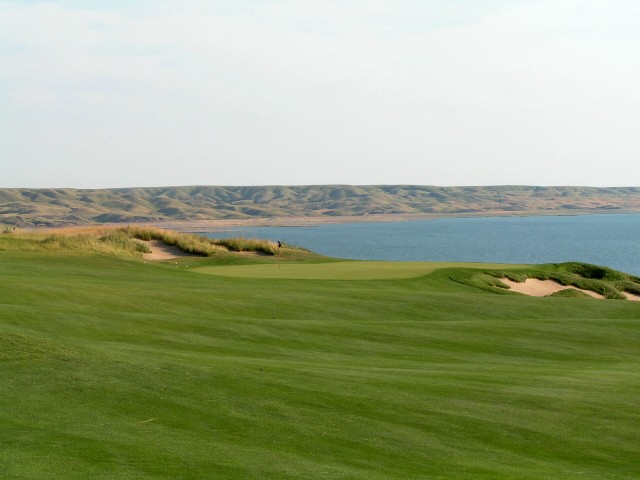
A closer view reveals the nice movement within the rolling fairway and the mirror image redan characteristics of the 16th green. Though into the wind, the architect gives players of all abilities the chance to fashion a good approach shot by leaving the entrance to the green open. The ground game is alive and well at Sutton Bay.
Seventh hole, 170/155 yards; Good design is about variety. With the golfer just having spent the last several hours in a huge expansive setting, he now comes to the penultimate hole and finds a green tucked between mounds in its own intimate amphitheater. Also, having just come off playing the long sixteenth into a wind, Marsh does his profession a favor by not building a typical long hard (and boring) 220 yard one shotter. Both the seventeenth and eighteenth center around finesse.
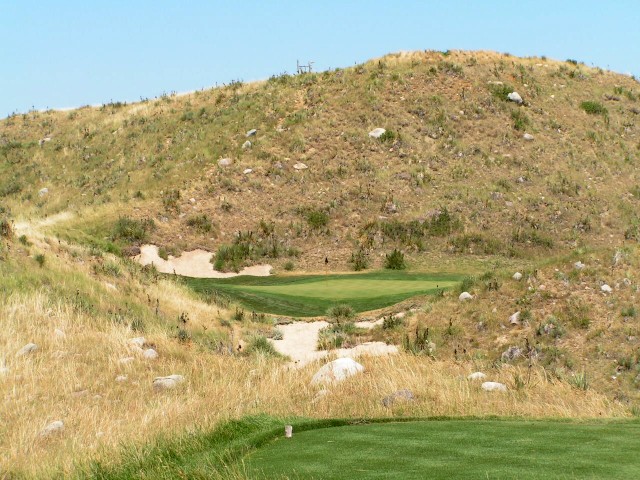
The 17th possesses a different look and feel than the other holes and the course is all the better for it.
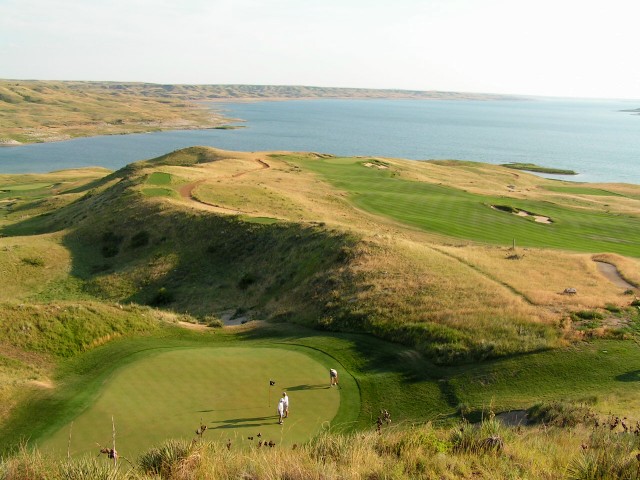
From the elevated 18th tee, a view down at the 17th green with the 16th hole stretching away in the distance.
Eighteenth hole, 465/400 yards; A tale of two tees, the lower tiger tee is just off the seventeenth green and requires a carry of 235 to reach the fairway. The upper tee is on top of the mesa and affords the golfer a panoramic view of over 900,000 (!) acres of prairie and Lake Oahe; surely this is one of the more unique spots in the world of golf. As with so much of the course though, the quality of the golf matches the views. From the 400 yard marker, the golfer delights in watching his tee ball bound along the wide fairway below. As Marsh did so successfully at Terrey Hills Golf Club outside of Sydney, Australia, the Home hole is about placement. A final piece of deception occurs at the green where the right side of the slender green is unguarded and the left is behind a bunker. Round after round though shows that the right hole locations may be the more tricky as the right half of the green slopes from front to back. The left side of the green, though guarded by a bunker, is more recepetive to holding the pitch and the putting is easier too as the putting surface is more flat.
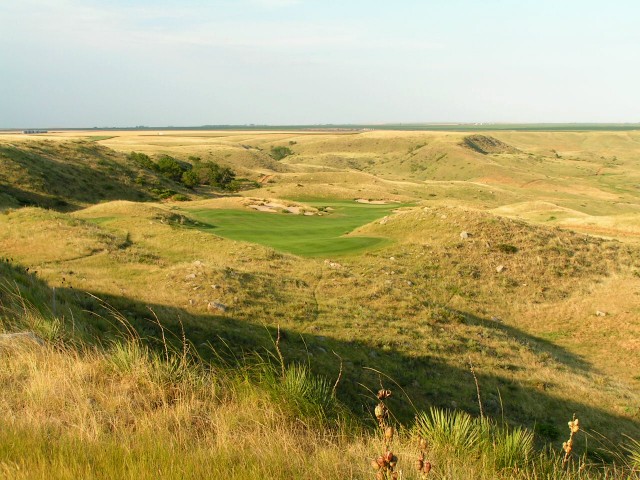
From the elevated 18th tee, the golfer is free to appreciate the South Dakota landscape without a single non-club related building in sight.
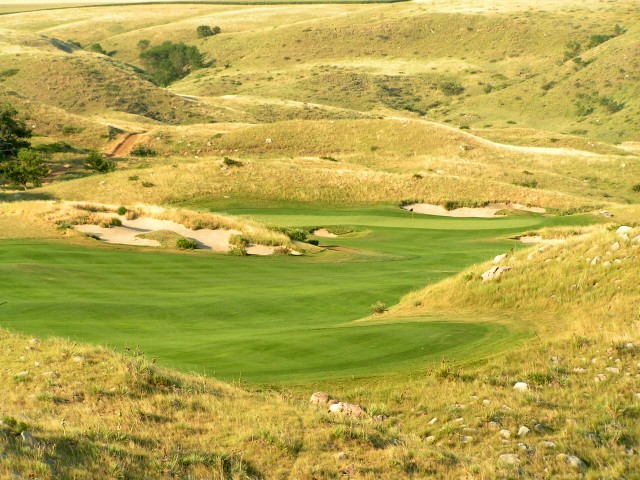
The bunker in the hillside on the left of the fairway is at the 100 yard mark from the green; any tee ball just to the right provides the best look at the green.
Down to the last putt on the last green, there is much to learn and appreciate about the design at Sutton Bay. So many of the finest design attributes from The Old Course at St. Andrews are on display here – wide fairways and large greens to give the course lots of playing angles, well positioned bunkers including many central ones, firm playing conditions, front to back greens, and awide variety of types of holes. Throw in the pristine natural setting in one of the prettiest parts in this great state and the golfer may understandably come to think that he has the best of both worlds.
The End



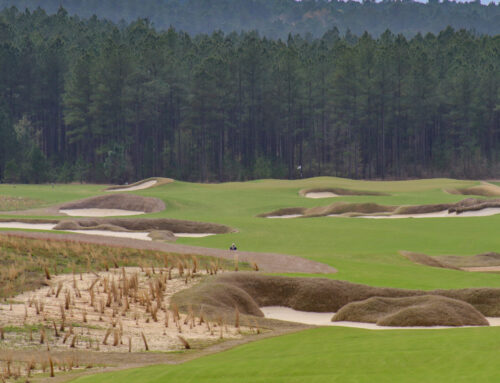


![The Park, West Palm (Lit 9) [2023]](https://golfclubatlas.com/wp-content/uploads/2024/12/IMG_7092-2-scaled-500x383.jpg)

